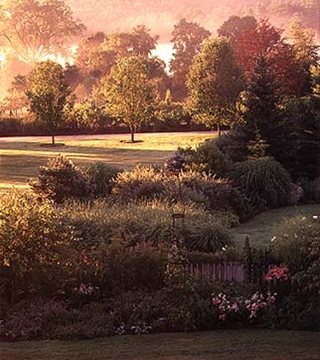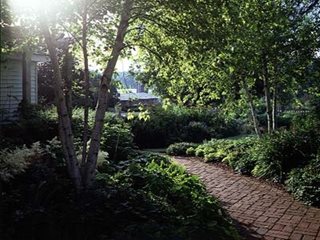Landscape Architect Judy Murphy's Connecticut Farm & Nursery
Quit the rat race, move to the country, fix up an old farmhouse, and spend your days outdoors, running your own nursery and garden design business. One designer's story.
Photo by: Matthew Benson.
It is commonly said that landscape architects are pros with structure and amateurs when it comes to plants. The cliché about horticulturists and nurserymen is that they’re so busy focusing on individual species, they lose sight of the big picture. Judy Murphy, though, is that rare garden professional who sees it both ways. Trained as a landscape architect, she can whip up a site plan for even the slipperiest slope. But she’s also a seasoned nurserywoman who waxes poetic about the latest cultivars and declares chartreuse foliage the ultimate neutral.

Photo by: Matthew Benson.
Murphy’s home garden — which shares 25 acres in Lakeville, Connecticut, with her business, Old Farm Nursery — is living proof of her wide-ranging talents. Like a design portfolio spread out across the land, it shows her mastery of the sunny flower border and the soothing shade garden, her talent with a loose grassy island and a formal potager. There’s a swimming pool near the house, a naturalistic pond farther out. Murphy seems to have it all.

Photo by: Matthew Benson.
Every gardener knows the fantasy: Quit the rat race, move to the country, fix up an old farmhouse, and spend your days outdoors, running your own nursery and garden design business. Get back to the land, simplify, relax ... ''Yeah, sure,'' laughs Murphy. ''You think it’s relaxing to work 15-hour days, seven days a week, from March to December? Talk about stress. Imagine the 93rd day without rain, when everything you’ve ever planted is dying. And forget about escaping in a small town. If you go out to dinner, you’re surrounded by clients. 'This isn’t about getting away from it all. I am always, totally and completely, surrounded by it all. Of course,'' she adds sheepishly, ''I don’t really know what it’s like to work in an office.''

Photo by: Matthew Benson.
The thought never crossed her mind. When Murphy went off to Cornell University, she — like many undergrads in the early 1970s — gave little thought to conventional, deskbound success. ''I didn’t want to study calculus in a windowless classroom,'' she says. ''I took beekeeping and art history and botany and agronomy, whatever I liked. Together, it all began to look like landscape architecture.'' After college, Murphy left the Northeast to help plant the gardens at the famed Greenbrier Hotel in White Sulphur Springs, West Virginia, where she was the only woman on an all-male landscape crew. ''It was the hardest thing in the world,'' she recalls. ''I was making the same $2.20 an hour as the men, so I had to prove I could earn it the same way. I almost killed myself digging holes in the ground. But I learned that there’s an amazing choreography to how people work physically together, the way they move around each other with pickaxes and shovels. I wound up loving it.''
So much so that she married one of her fellow crew members, West Virginian Patrick Murphy. And though she left the crew after a few years to open her own landscape business, Murphy stayed in West Virginia for more than a decade. ''Like many Yankees, I came expecting bleak coal-mining country, with the forests clear-cut. It’s actually one of the most beautiful places on Earth. I could have stayed there forever,'' she sighs. ''But, unlike me, Pat had never lived anywhere else, and he was ready to take a risk.''

Photo by: Matthew Benson.
So in 1988 — with their 2-year-old son, Cory, and another, Greg, on the way — the couple moved to northwestern Connecticut. It was close to Judy’s family, she explains, but ''the landscape looked like West Virginia, all knotty and bumpy, with fantastic views.'' She and her husband found an early-1800s fixer-upper on a farmstead near the small town of Lakeville and hung up their Old Farm Nursery sign. ''Our first client,'' she laughs, ''was our plumber. Then we designed a garden for a neighbor. He liked what we did, and told the people down the road, who mentioned us to someone across the street. We never advertised.'' The Murphys have since designed, installed — and, in many cases, maintained — gardens for more than 200 clients. The nursery, which covers 10 acres and fills all seven of the farm’s outbuildings, now sells garden ornaments and furniture, as well as plants. And the pas de deux that Judy and Pat established on the landscape crew has evolved into an elaborate dance performance. ''I’m like the director,'' she explains, ''and Pat’s the producer. I’m horrible. I spew out designs and ideas a mile a minute, and then I’m on to the next thing. If it weren’t for Pat, nothing would happen. He makes everything real.'' During the busy season, a staff of 10, including Pat’s father, helps out.
As business skyrocketed, though, Murphy spent less time in her own backyard. ''For a client, I sit down, draw up a plan, and we install everything at once. But our garden happened bit by bit, which is how everyone’s garden happens if they don’t hire someone else to do it.'' In the beginning, if a nursery shrub came off the truck with a broken limb, Murphy would stick it in her yard. Distinct garden areas evolved as she searched for solutions to everyday problems: ''The kids were small, so I needed a fenced yard for them to play in. I wound up experimenting with a perennial border in there. I wanted privacy from the road, so I planted a row of fast-growing arborvitae. It’s the usual stuff people deal with: I wanted fresh produce, so I set aside an area for edibles; I needed a way to get from the garage to the back of the house, so I laid a brick path and began planting around it.''

Photo by: Matthew Benson.
Despite Murphy’s Everyman approach, the sprawling result is far from usual. ''Please,'' she demurs, ''I don’t do all of this myself.'' Because the garden helps fuel the business — attracting new clients, showing existing ones how a shrub will look, even getting the casual nursery customer excited — some business resources, like staff and money, go toward keeping it maintained. ''Our lawn has to be mowed,'' she explains. Even so, Murphy admits that it’s only in the past few years that her place has really come together, and she’s still fine-tuning. ''No gardener ever looks upon a garden as finished. To other people that may seem scary. To me, it would be frightening if I couldn’t change things. I like that I can always rip this out and put something else in.''

Photo by: Matthew Benson.
Spend a day exploring her property, though, and it’s hard to imagine what, if anything, Murphy could add. Out by the road, grasses and daylilies sway around a strong core of evergreens. Pull into the driveway, and your eyes are bombarded by pots, troughs, and obelisks in front of a red barn. Hundreds of trees, shrubs, and perennials stretch into the distance. Coming here from the city is like going to the grocery store on an empty stomach. And you’ve only glimpsed the nursery ... Murphy’s garden begins on the other side of the driveway, with a profusion of roses climbing a picket fence — the one built for the children. Inside, the perennial border, which undulates around the lawn, looks at first like a sweet, old-fashioned cottage garden, but closer inspection reveals a wry sense of humor. Lurking amid peonies and roses are the huge, outrageous leaves of a cardoon; at regular intervals, standard-trained crab apple trees and funky iron towers rise from mounds of veronica and bachelor’s-buttons. This is enough, you think, looking around. I would be happy with this one perfect plot.

Photo by: Matthew Benson.
Then your eye catches the brick path. You follow it and find yourself in a shade garden, where astilbe, lady’s mantle, and nicotiana cool off beneath white birches. The path leads you farther behind the house, into yet another room. This one is actually just a lawn shaded by a huge Norway maple. But twig furniture and ''walls'' — flower borders on each side and a wooden grape arbor at the back — transform the space from a plain backyard into a knowing take on classic American simplicity.

Photo by: Matthew Benson.
Later, after you’ve discovered the swimming pool tucked discreetly behind the arbor, when you feel that you can’t possibly nibble one more morsel of this horticultural feast, Murphy serves up her main course. Across the backyard, opposite the shade garden, there’s a gateway flanked by two old terra-cotta chimney pots. Step through them, and there, hidden from the highway by arborvitae, is the most spacious room yet. Only this one doesn’t have a back wall. When the rows upon rows of vegetables finally end, the garden opens up again, framing an endless blue sky and rolling hills flecked with red barns. Suddenly, despite all of Murphy’s earlier warnings, you see the vast possibilities of country life. And you want it bad.
She understands. ''This isn’t easy,'' Murphy says again, ''but if you’re lucky, the work can make you wise. We’re slaves to the weather, and it can be frustrating. But we’re also in sync with it. To be so intimate with nature, with soil and frost and sun and rain, is amazing. It connects you to something larger, gives you a way of seeing something much bigger than yourself. And you can’t buy that on Wall Street.''
See more New England gardens.

